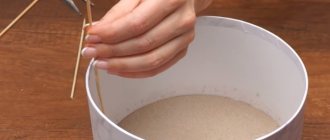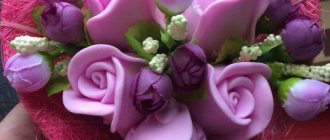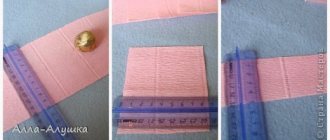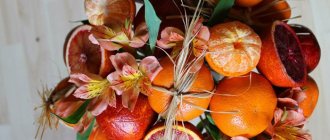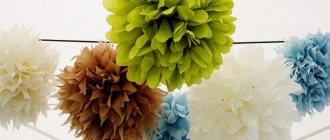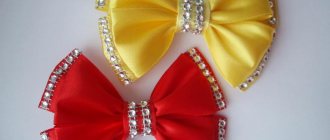Making a bouquet is a complex procedure for beginners, which is performed according to certain rules. You cannot collect all the flowers you like in one bunch, decorate them with a couple of sprigs of greenery and pass them off as a beautiful bouquet. The composition must maintain a balance of shades and combinations of different plants. Another important nuance is the moderate use of decor so that the base of the bouquet does not get lost against its background. In addition to everything, flowers must be arranged in accordance with the rules of the language of flowers, which has nothing to do with linguistics. The amount of complexity for such a seemingly simple task is surprising, isn’t it? Let's talk about how to properly arrange a bouquet.
What do flowers say?
The language of flowers is the symbolism given to certain plants in a bouquet. This subtle, refined way of expressing feelings appeared in the East. According to legends, it was invented by women who, due to the peculiarities of local customs, did not have the opportunity to communicate fully. They began to put the range of their feelings into bouquets. One of the French monarchs brought the basics of the art of composition to the Old World after a friendly visit to the Persian king. The language of flowers has gained particular popularity in the territories of England and France. In these countries, they even began to publish special booklets and dictionaries containing lists of plant names with their symbolic meaning. The language of flowers is widely used by florists. In this case, not only the flowers themselves are important, but also the shades of the buds and the number of participants in the bouquet. Below are examples of the meanings of the most popular plants:
- Rose (red) - declaration of passionate love.
- Violet is a symbol of fidelity and fragility.
- Daisies speak of simplicity and unobtrusiveness.
- Lily personifies greatness, nobility, luxury. Suitable as a gift for a woman who is adored.
- Chrysanthemum is a symbol of good health and longevity. In some countries this flower is sacred.
- Poppy signifies grief and loss.
- Gerbera personifies lightness and coquetry. Suitable as a gift for a woman whose relationship is just beginning.
- Carnation is a symbol of courage and perseverance. "Male" flower.
- Gladiolus represents courage, nobility and brings good luck.
- Iris is the flower of pride (not to be confused with arrogance) and wisdom. In Japan, ayame (iris flowers) in shades of blue, blue and lilac are considered exclusively “masculine” colors. Only they could be given to men of the samurai class.
- Lilies of the valley express sensuality, innocence, fragility. Usually they are given to young Turgenev girls.
- Lilac symbolizes freshness and youth.
Red flowers are a symbol of passion. Pink speaks of sensuality and grace. Blue flowers symbolize fidelity. Whites represent purity and innocence. Yellow, depending on the “neighbors” in the bouquet, can speak of both separation and nascent love.
Basic techniques and rules for composing bouquets
Among the variety of techniques, there are three traditional methods that can be safely classified as classic:
- Biedermeier. The bouquet can have three shapes: flattened, round, pyramidal. All participants in the composition fit very closely together. A striking example of decoration in the Biedermeier style is the bride’s traditional wedding bouquet. The stems of the plants are wrapped with decorative paper or ribbons and form one thick “leg”.
- Parallel. The bouquet is assembled using a “ladder”. The composition has no center; the buds form parallel rows, which gradually narrow towards the top of the cascade.
- Spiral. The composition is based on the central flower. Other plants are sequentially added to the bouquet, forming circles. Their stems are applied to the stem of the central flower at an angle, slightly diagonally. If you look at the composition from above, you will get a spiral, hence the name of the technique. The stems of the flowers touch each other only at one point, where the bouquet is pinched with the florist's fingers. The composition is completed by adding a border of green leaves.
There are many subtypes of the above techniques and the lists are replenished every year, since the imagination of florists, as well as the perfection of bouquets, has no limits.
The most popular types of flowers for spiral technology are chrysanthemums and roses. Their buds have different colors, so a bouquet of identical plants does not look boring and monotonous.
Roses have very strong, strong stems. Gerberas can also be used to form flower “caps”, but each stem will have to be pre-reinforced and wrapped with transparent film. Their stems are quite strong, but there is a discrepancy between the weight of the flower head and its support. For this reason, gerberas often “break” at the sepal itself. Carnations are also suitable for this type of assembly, but due to the fragility of the stems, only high-class professional florists can work with them.
Peony - the king of all flowers
Peony is an ancient flower, worthy of artist’s paintings and palace rooms. In its splendor and beauty it has always competed with the rose. It is often used for holiday and wedding bouquets. It is not necessary to have special skills - decorating a bouquet of peonies beautifully will not be a difficult task.
You need to choose buds that are not fully bloomed. You can use either single-color flowers or a combination of several shades.
Take 5-7 flowers that you like. When forming a composition, apply the buds tightly to each other. The stems must be trimmed and excess leaves removed. You can insert greenery into flowers; almost any will go well with peonies.
Types and shapes of bouquets
Bouquets, depending on the design style, are classified into three types:
- Women's. Bright, voluminous compositions.
- Men's. Discreet bouquets with strict, straight lines.
- Neutral. They are used as a decorative element and decorated in accordance with the style of the room.
There is another classification according to form:
- Round. This is a classic form that can be considered a win-win option. A round bouquet easily integrates into any decoration. In combined compositions, large buds are placed at the bottom, and small inflorescences are placed closer to the top.
- One-sided. All participants in the composition “look” in one direction.
- Asymmetrical. Flower buds are directed in different directions, while the composition is carefully balanced.
- Linear. The flowers are arranged in a cascade on one line. The lower ones have short stems. The higher the bud, the longer its “leg”. The bouquet looks luxurious and impressive.
There are also creative ways to arrange bouquets:
- In a wicker basket or molded box. The bouquet is ideal for decorating a table or windowsill.
- Animal figurines on a rigid frame. Creating such a composition requires skill from the florist, so this option is not suitable for beginners.
- Another rare species is the glamelia or bouquet flower, which is collected from the petals of many buds, gluing them together.
Master class: round bouquet with decorative mesh
Dear friends, have you noticed that buyers flock to a beautifully decorated flower display like bees to honey? Especially if it attracts attention with its richness and diversity, and each individual bouquet has its own character and style. Therefore, the more bouquet design options you use in your flower shop, the higher the likelihood that the buyer will find exactly what he likes.
Today we invite you to take with us a simple step-by-step master class on making a round bouquet using a decorative mesh. Having composed such a bouquet once, you will be happy to compose it again and again, because such simple but effective compositions will sell like hot cakes.
For work we will need:
- from 7 to 17 branches of white chrysanthemum;
— floral aerosol paints of various colors;
- any decorative mesh;
- stapler;
- decorative clothespin and stone beads.
1. Before we start working, we will tint the flowers a little. We paint each chrysanthemum branch a different color by spraying paint into the center of each flower.
The more chrysanthemum branches, the richer the bouquet will look and, accordingly, its price will be higher.
2. When the flowers are painted, we begin to compose a bouquet, laying out branches from the central flower in a circle. In each next circle we place the branches a little lower, as if at an angle, to make a ball. With this method of composing the bouquet will turn out to be very lush and attractive. If there are few flowers, we simply arrange the branches next to each other. Don't forget to use greens. We use bergras and ruscus. Next we tie the bouquet and trim the roots a little.
3. Now let's move on to packaging. We use mesh, but not quite ordinary, but sort of rubberized to the touch. We cut off three not too wide strips from it; one, narrower one - for the legs and two identical ones, a little wider - for decorating the bouquet. You can also cut square pieces, but in order to save material, we still recommend that you use rectangular ones. This will not affect the appearance of the bouquet, but the mesh will take half as much!
4. Take one of two identical strips of mesh and bend it at the top into a triangle, then secure the triangle with a stapler. We do exactly the same with the second strip.
5. Next, we take our bouquet and place it on a piece of mesh so that the triangle looks up, then we wrap the bouquet in the mesh and secure the material with a stapler. We frame the bouquet from the opposite side with the next strip using the same principle and secure it from the bottom. We tie the bouquet with a ribbon. Thus, our bouquet formed ears protruding in different directions.
6. The next step is to fold up our ears and secure them with a stapler. There are many options on how you can do this, and you can use any of them. So, we have a beautiful round bouquet!
7. Now the leg. We take a narrower piece of mesh and wrap it around the flower stems in a spiral, then tie it with ribbon at the bottom.
8. Decorative elements will help to bring even more summer and sun into our composition. We will put a decorative wooden flower pin on a sprig of ruscus, and string beads and stones onto the leaves of bergrass. Our bouquet is ready to delight customers!
If your retail outlet is located on the street, we recommend using additional packaging - regular transparent film. Then the flowers will not become weathered and lose their freshness and beauty.
The top corners of the packaging can be decorated with butterflies - pieces of mesh, secured with ribbon in the center.
We thank you for your work and believe that the new practice has been useful and will bring you good profits in the future.
Video tutorial on making a round bouquet with a decorative mesh.
Similar articles:
All about flowers → How to preserve flowers so they last longer
Flower business → How to do business smartly? Hire people to work less!
Travel → “Ship of Flowers” Mainau
Flower business → Information about the flower business. Excerpt from my correspondence with Mikhail Oktysyuk
All about flowers → The language of flowers. What do flowers mean
Combination of flowers in a bouquet
In addition to the combination of shades, the flowers in the bouquet should look good with each other and “get along” in the same vase. For example, despite their external compatibility, the following plants cannot be combined:
- Carnations with lilies of the valley.
- Lilies with daffodils.
- Carnations with roses and lilies.
- Lilies and cornflowers or poppies.
With such proximity, the flowers will begin to fade quickly. Rose is the universally recognized queen of flowers. As befits a crowned “person,” she is extremely capricious, so in bouquets she is often surrounded only by decorative greenery (asparagus, fern leaves, palm trees, spruce branches).
The composition turns out to be balanced and complete, but even a rose can have neighbors. And not from the “lower classes,” but the same “flower nobility” of a slightly lower rank. The following can act as a rose retinue:
- Lilies.
- Chrysanthemums.
- Gypsophila.
- Gerberas.
Another “royal” flower is the magnificent lily. For five centuries and up to the present day, the “fleur de lis” has been the constant heraldic symbol of the European Bourbon dynasty. Over the years, the flower has become automatically associated with high status, wealth, luxury and nobility. As another representative of the “blue-blooded” flower aristocracy, the lily tolerates the proximity of only those plants that do not try to outshine its own beauty. It should shine, and the shine will be brighter against a faded background. You can add to the bouquet of lilies:
- Chamomiles. Too rustic wildflowers will only highlight the sophistication of noble lilies.
- Irises.
- Phloxes.
- Peonies.
- Primroses.
Lush peonies also occupy a fairly high position in the “flower society”, but at the same time they do not boast of their origin, like roses or lilies. They perfectly coexist with small inflorescences, shading the flowers of large buds. Suitable for a bouquet of peonies:
- Daisies.
- Marigolds.
- Mattiola.
- Freesia.
- Forget-me-nots.
Irises are refined representatives of the upper class, but with a “broad” soul, which makes it easy to make acquaintances with flowers of a lower class. Although they are endowed with certain regalia, they calmly relate to the proximity of kniphofia (both in a bouquet and in a flowerbed), tulips, and lavender. From whom no one really expected whims were the simple village “suns” - sunflowers.
But they really don’t tolerate any neighbors at all in a bouquet arrangement. Even “from the outside” they treat greenery with aversion, preferring their own wide leaves as decoration. The male flower, the carnation, with truly iron endurance, steadfastly endures the proximity of a wide variety of flowers:
- Chrysanthemums.
- Asters.
- Crocuses.
- Anemones.
- Dahlias.
Prickly twigs of ruscus and graceful bergrass are used as decoration for bouquets of carnations. Gerberas, more reminiscent of large multi-colored daisies, welcome both noble roses or chrysanthemums and “simpler” wildflowers with equal delight.
Colors of the bouquet
There are three main colors used in floristry:
- Yellow.
- Red.
- Blue.
Green acts as a decor, but the center of the composition is always captured by the representatives of the trio. They organically complement each other. Yellow and red are warm, sunny colors. Blue and its shades (blue, violet, lilac) are cool tones. The color temperature of green is also quite “low”. Pay attention to bouquets consisting exclusively of blue flowers. They look strict and unapproachable. The coldness of the blue is greatly enhanced by the surrounding greenery. It is enough to add a couple of warm yellow, orange, red notes to the bouquet and the composition is filled with inner light, its “mood” changes dramatically. Neutral white can set off the brightness of its neighbors or be used on its own in delicate bouquets. For example, white roses do not need any additions.
Decorated with a sprig of asparagus and wrapped in an envelope made of transparent film, they become the personification of luxurious laconicism. Plain bouquets of delicate flowers (pink, white, pale yellow) can be diluted with notes of greenery. The blue color combines perfectly with yellow, and one of its shades, blue, with soft pink. Another elegant, win-win combination is white and red.
How to pack flowers in a box
Packing a cascading bouquet of flowers in a box
Required:
- cardboard box with lid. The dimensions of the box are determined by the size of the bouquet;
- satin ribbon;
- gift paper;
- fishing line with beads of several diameters - optional;
- scissors.
Package:
- Decorate the stem of the bouquet with a neat satin bow.
- Line the bottom of the box with gift paper.
- Place the bouquet in the box.
- Decorate the bouquet with beads on a fishing line.
- Cover the box with a lid, tie with a satin ribbon, and decorate with a bow.
How to pack flowers in a hat box
Arrangements in hat boxes look stylish and do not require a vase. To extend the life of flowers, you can carefully water them.
Required:
- hat box. The size is determined by the number of flowers in the composition;
- floral foam (oasis);
- floral knife;
- film;
- container with water;
- pruner;
- ribbons, stickers, double-sided tape - optional.
Packing flowers: master class on creating a hat box:
- Using a floral knife, cut a cylinder of the required diameter from a layer of floral foam. It is convenient to use a box lid as a template.
- Place the floral foam cylinder in a container of water. The part will gradually fill with water and sink to the bottom of the container. You cannot press or squeeze the floral foam.
- Cut a square of film large enough to line the bottom and sides of the hat box.
- Place floral foam in the center of the film square and carefully transfer the film and foam into the box.
- Straighten the film and carefully cut off the excess edges with scissors.
- Decide on the length of the stems based on the height of the box, the height of the floral foam and the level at which the flower heads will be located. It is convenient to measure the required length of the stem by placing the flower on the box with the inflorescence down. You need to cut the stems with pruning shears at an angle of 45 degrees.
- Assemble a flower arrangement.
- If desired, decorate the box with ribbon or a sticker.
- If the flower heads are located above the edge of the box and it is not possible to cover it with a lid, then you can put the box in the lid. To prevent the lid from slipping during transportation, it is attached to the bottom of the box in several places with small pieces of double-sided tape.
Hat box: photo of packed flowers:
Using the same principle, you can fill a box in the shape of a rectangular parallelepiped with roses.
Packing roses in an acrylic box
Required:
- clear acrylic box;
- roses;
- pruner;
- water;
- napkin;
- decor - optional.
How to pack flowers in an acrylic box step by step:
- Pour a few centimeters of water into the box.
- Wipe the sides of the box with a napkin to remove droplets of water.
- Remove thorns, castings, sepals, and the first row of petals from roses.
- Determine the required length of the stems based on the height of the box and how much the flower head will protrude beyond its edges. Use pruning shears to cut off the excess at an acute angle.
- Carefully place the roses in the box so that the stems are perpendicular to the bottom.
- Decorate the box if desired.
Design rules
In a correctly assembled bouquet, the secondary participants in the composition organically set off the main “central” flowers. Assembly starts from the middle. First, the “backbone” of the bouquet is collected, to which its surroundings are gradually added. When choosing colors and shapes, they are guided by the gender and age of the person for whom the floral gift is intended:
- For young girls, small round bouquets consisting of wildflowers or decorative roses are suitable.
- It is customary to give discreet bouquets of asymmetrical shapes with elongated lines to young boys and men.
- For women of Balzac age, voluminous bouquets of roses, asters, chrysanthemums or gerberas are suitable.
- Elderly representatives of the fair sex are given lush round-shaped bouquets consisting of buds of bright and juicy flowers. Packaging plays a big role in the bouquet. It must be carefully selected for the content.
Bridal bouquet
Flowers for the bride are an important part of the celebration. They represent purity, beauty and inner peace. When choosing flowers, you should take into account the age of the bride, the style and color of the dress. Of course, you can order decorated flowers from a store, but this is too simple. It will be much more pleasant for the bride if the groom decorates the bouquet with his own hands.
For a wedding bouquet, it is best to purchase one of these options: roses, peonies, Italian ruscus, shepherd's purse greenery.
The round shape of the bouquet is considered classic . To work on such a bouquet, you should purchase pruning shears, a glue gun, oasis, scissors, a porta bouquet maker, wire, twisted cord, double-sided tape, and decorative pins.
The first thing you will need to do is decorate the handle of the portaquet holder. This can be done in various ways, it all depends on your imagination. In this particular case, we will decorate the handle with aspidastra leaves and a screw cord. Before starting work, you need to remove the grille from the portaquet holder and fill the handle with absorbent materials. This will prevent excess moisture when the flowers are inserted into the oasis. Under such circumstances, the handle will not get wet. The next step is to put the oasis in a container of water and leave it there for a while. The “readiness” of the oasis can be determined by a change in color.
The prepared oasis must be placed in a portaquet holder and secured with a lattice. With the help of technical wire it can be securely fixed. Excess pieces of wire must be carefully removed.
Flowers can be placed in a bouquet holder decorated in this way. The first step is to cut the aspidastra leaf into several parts and place it on the base of the bouquet. Then secure it all with double-sided tape. The leaves are not laid overlapping , but one to one. Using a gun, decorate the handle of the bouquet holder.
Variety of materials for decoration
There is a huge selection of wrapping materials that vary in color and texture. The most popular include:
- Corrugated paper. Its edges are compacted using a special machine.
- Film. The classic version is transparent. It is used when making envelope bouquets, for packaging single flowers (popular for the holidays of May 9 and September 1 for school), as a component of a complex wrapper made of several layers of different materials.
- Floral mesh. It looks like a dense “holey” material that holds its shape perfectly.
- Craft. Classic wrapping paper. It goes well with any bouquets and adds laconic notes to the composition.
- Organza. Translucent material that perfectly emphasizes the richness and luxury of the bouquet.
As additional decor use:
- Ribbons. The undisputed leader among jewelry. They are “let out” in waves along the edge of the package, from them they are collected into lush bows using a stapler, cut into small, “curly” ribbons, which are sprinkled on top of the flowers.
- Sisal. The fibers of agave leaves are pale brown. They add a touch of exoticism to the bouquet.
- Ropes. Usually simple twine is used. They tie up craft paper packaging or complement the design with sisal.
In more expensive bouquets, satin ribbons can be used instead of simple ribbons. The bows they make are softer and neater.
Decoration with floral mesh
Floral mesh is made from natural fibers, does not fade in the sun, is not afraid of water, and does not have an unpleasant odor, as is the case with film. It gives the bouquet a touch of tenderness and grace. Available in various color variations. Can be coated with glitter. It is usually used in a bouquet without additional packaging materials, since the mesh itself looks luxurious. The sharp corners of the wrapper can be easily straightened, giving the composition volume. Typically, flowers are wrapped in several layers of wrapping to make the mesh material appear denser.
Packing a bouquet in film
Packing a bouquet in film is a classic option. The material can be used both for “envelopes” and for lush compositions. In the first case, a piece of film is cut from the roll and unfolded on the table. The flower is placed diagonally at one of the corners. After which they begin to wrap it in film. The second corner is fixed with tape. In lush bouquets, the film is collected “accordion-style” around the base of the composition, while holding it in the hand. If the flowers are arranged in a cascade, then the substrate for them is made separately.
A piece of material cut at the corners is also assembled like an accordion, fixing it at the base with a stapler. After this, the packaging is wrapped around the bouquet and its edges are secured to each other. Transparent and translucent film looks beautiful in combination with corrugated paper and opaque wrap.
Decoration with corrugated paper
Corrugated paper is widely used in handicrafts and in the design of bouquets and gifts. The surface of the material is “crushed” in a special machine. Corrugation sizes may vary. For gift packaging and bouquet wrappers, small “accordion” paper is used. The material is easily stretchable, so it can be deformed to your taste, adding volume to the composition. To make the bouquet look neat, before using the paper, its edges are processed using a special machine that tightens the folds and fixes them. The edges of such a sheet turn out to be “wavy”. Corrugated paper looks good with floral mesh and film wrapping. Unlike these materials, it is afraid of water. It's better to use double wrap. The base is made of corrugated paper, and the outer short packaging is made of waterproof material.
How to pack flowers in craft paper
Simple packaging of flowers in kraft paper
Required:
- 2 rectangular sheets of kraft paper;
- stapler and staples;
- ribbon.
Package:
- Fold a sheet of paper along the long side slightly diagonally.
- Make 2 cuts along the fold line.
- Carry out similar manipulations with the second sheet.
- Wrap the bouquet one by one with the packaging elements.
- Straighten the packaging, fasten its upper parts with a stapler.
- Secure the packaging at the bottom with a satin ribbon.
Using kraft paper to wrap flowers. The video below will demonstrate 4 different easy methods.
Kraft paper and vinyl flower packaging
Required:
- 2 sheets of kraft paper measuring 50x50 cm;
- 1 sheet of vinyl measuring 45x45 cm; sheet of vinyl measuring 22.5x45 cm - optional;
- narrow transparent tape;
- stapler with staples;
- double-sided tape/glue gun and a rod for it - optional.
Manufacturing of packaging:
- Place a sheet of paper in a diamond shape on a hard and flat surface.
- Place a square piece of vinyl on the paper so that the centers of the figures are at the same point, and the distance between the sides of the squares is approximately the same.
- Place the bouquet on the future substrate, the inflorescences should be slightly above the center of the figure.
- Wrap the sides of the lower half of the rhombus over the bouquet and secure the backing in this form with tape.
- Take a sheet of kraft paper, fold it as shown in the photo, and work out the fold line.
- Cover the front side of the bouquet with the resulting element so that two are facing up. Wrap the sides of the element around the bouquet and secure the packaging with a stapler.
- At this stage you can stop.
- If you want to give the bouquet packaging a more elegant and unusual look, you need to cover the perimeter of the wrong side of the vinyl rectangle with double-sided tape and attach the decor to the front side of the bouquet.
- Kraft paper and vinyl packaging is ready.
Making a bouquet of roses at home
As a first experience for beginners, it is better to choose simpler compositions. Roses are ideal in this regard, since luxurious flowers do not need lavish decoration. They will look equally elegant either in a transparent film or in a corrugated paper wrapper. Garden decorative roses have uneven stems and a large number of buds on one branch. From these flowers it is better to collect miniature round bouquets, similar to wedding ones, or compositions in a basket. Exquisite roses on long stems are suitable for lush bouquets and “envelopes”. The latter look more laconic, but are ideal as a gift for the woman you love. Let's look at a short master class on assembling a simple bouquet:
- First you need to cut a small piece of transparent film. It is crushed and compressed, forming a dense “ball”.
- A lump of film is wrapped with tape. This “ball” will become the basis of the bouquet.
- Holding it in your hand, they begin to attach one rose in a circle, pinching each stem with their fingers.
- Now you can add some greenery. Roses go perfectly with asparagus and gypsophila. The composition is tied with a ribbon, securing the stems to the base ball.
Next we proceed to packaging:
- Cut a piece of film.
- Its edge is pressed to the base of the bouquet. Now they begin to gradually wrap the composition in film, while at the same time assembling the packaging “accordion-style”.
- The ends of the film are fastened with a stapler.
- At the base, the bouquet is tied a second time with a decorative ribbon.
- If desired, you can attach a bow to it.
- Thin ribbons are “twisted” using scissors. They are sprinkled on top of the roses to make the bouquet look elegant and festive.
You can run waves of thin tape along the edges of the package, fixing the points of contact with the film with staples.
The final touch of floral arrangement
For those who grow luxurious flowers at the dacha or in a country house, there is no point in giving purchased compositions. Fresh cuttings from your own garden always look much more attractive than store-bought exotics grown unknown where and when. The only obstacle is the decorative design of the “home-grown” composition. However, by watching how professional florists wrap flower bouquets with paper in master classes, you can learn a lot.
Laconic solution
A simple and common option for decorating a bouquet using craft. Suitable for any type of arrangement, including food floristry. For example, for a delicious composition of marshmallows, marmalade and marshmallows.
You will need:
- 3 rectangles from double-sided craft (you can take a roll or a ready-made sheet)
- scissors, stapler;
- decorative tape.
Fold each craft sheet diagonally and cut off the excess.
We also bend the resulting squares, but in such a way that the opposite corners diverge slightly to the sides. We cut the folded sheets so that they better cover the bouquet.
Food floristry involves piping products onto bamboo skewers, replacing ordinary flower stems. Since these auxiliary structures do not look very attractive, they try to disguise them with packaging material. When arranging a composition of living plants, you can skip this step.
We place the “stems” of sweets in the middle of the craft sheet.
And, crumpling the paper, we form the stem of the bouquet.
Then we lay the sheets folded in a triangle around the arrangement, making sure that they partially overlap each other.
At the junction of all the fragments of the packaging, we tie a decorative ribbon.
Check to see if the sheets fit tightly. If any of them comes off, we secure it with a stapler. This is such a spectacular gift you can make with your own hands.
Kraft plus vinyl
The combination of rough wrapping paper with glamorous gold film is very elegant. Against its background, a mono-bouquet of fragile tulips or other spring buds will look very elegant.
You will need:
- 2 square craft sheets with a side of 50 cm;
- a piece of vinyl film 45x45 cm and a rectangle 22x45 cm;
- stapler, 2-sided and narrow transparent tape.
Place a square piece of vinyl on the craft sheet so that there are equal spaces on all sides. We arrange the flowers diagonally. We bend the craft with vinyl around the stems and secure it with tape.
We bend the second paper square diagonally, but slightly obliquely, as shown in the photos below. We decorate the lower part of the arrangement in front with the resulting detail, wrap the ends back and fix them with a stapler, connecting them to the “background” sheet. You can stick the vinyl on top with 2-sided tape.
Variation on the “Korean” theme
The arrangement technique that developed in the Asian country has become incredibly popular all over the world. Its main difference is the large number of sheets and layers that make up the bouquet wrapper. The lush composition does not look bulky due to the use of translucent materials such as tracing paper, light colors and the compactness of paper fragments.
Step-by-step description of the process:
- We fold small wrapper rectangles as in previous master classes: diagonally with an offset to form “corners”.
- We wrap the bouquet with the resulting elements, laying them overlapping. In front we open the composition more strongly, in the back we make a background from tracing paper. We secure the wrapper with twine so that it does not fall apart.
- On top of the first layer we form a second one - from double-sided craft. Sheets need to be taken larger, but laid similarly to compact rectangles of tracing paper.
- All that remains is to tie the resulting beauty with a satin ribbon and you can give it as a gift.
Arrangement of bouquets of fruits and berries
Fruit and berry bouquets are a stylish, beautiful, original gift. They are easy to assemble with your own hands at home if you have toothpicks and strawberries, apples, grapes, raspberries, bananas, and citrus fruits on hand. Bouquets made from berries look more sophisticated, but you will have to be more careful when working with such fragile material. Sometimes compositions are supplemented with sweets: meringue, marshmallows, candies. Consider step by step the stages of performing the work:
- You should start composing the composition with the frame. You can use a regular wicker basket or make a container out of yarn. For this you will need a plate or bowl. It is turned upside down, covered with cling film, thickly coated with glue and covered with a layer of yarn. The threads are placed randomly. The “thicker” they lie, the stronger the decorative container will be. After drying, the frame is removed and separated from the film.
- You need to put a base into the frame: a piece of foam plastic, a floral sponge.
- Berries and fruits are strung on skewers for canapés or pieces of thick wire.
- With the opposite end they are fixed in a pliable base.
- The heavier the fruit, the thicker the wire you need to use for it.
- You can take fruits not only whole, but also cut them into pieces.
The composition is made according to your taste. You can add absolutely any inedible decor to it: artificial flowers made of foamiran, polymer clay, felt toys, buds made of light tulle, real twigs with green leaves, sisal fibers, cotton “buds,” real daisies, roses, sunflowers.
Design and assembly of men's bouquets
As mentioned above, men's bouquets are characterized by asymmetry and angularity with elongated lines. Streamlined shapes are the lot of women's compositions. For a men's bouquet, it is better to choose exotic flowers with an unusual “appearance”: irises, strelitzia, calla lilies, anthuriums. Fern branches, bergrass, and Dracaena Sander (lucky bamboo) are used as decoration. Men's bouquets are composed according to the cascade principle: first, the base of the composition is selected, on which “steps” of secondary decor are applied. The composition is complemented with natural materials: sisal, jute (twine), neutral colored ribbon (brown, green, yellow, purple). For a close man with a good sense of humor, you can create a bouquet not from flowers, but from products so adored by the stronger sex. Compositions of different varieties of sausage, ham and bacon are becoming increasingly popular. The most delicate petals and buds are formed from thinly sliced meat slices, decorating them with olive decoration, leaves of cheese, bell pepper and beads of peas and cherry tomatoes.
Avoid using bright bows and flashy packaging materials. It is best to wrap a man's bouquet in plain craft paper. There shouldn’t be any “skirts” on the packaging either.
Design of wedding bouquets
Wedding bouquets have the correct spherical shape. Due to their miniature size, flowers with small buds are used in the composition. Just a couple of years ago, the main feature of such a bouquet was the stems tightly tied with ribbons, which formed one thick “leg”. Nowadays they assemble looser compositions, wrapping them with ribbons, the long ends of which are deliberately left to flutter. The stems are tied with the finest lace, decorated with embroidery and beads, pearl threads and coarse jute, and ropes. The design of the bouquet depends entirely on the style of the wedding.
Making and decorating boutonnieres
A boutonniere is an essential element of the groom’s wedding suit. As a rule, it consists of one or several buds and is secured in the buttonhole of a jacket. To make boutonnieres you will need:
- Wire.
- Tape.
- A fresh flower and a couple of sprigs for decoration (rosemary, lavender).
- Ribbons, beads, a piece of tulle.
Stages of work:
- First, fresh flowers are placed in water and allowed to soak in the liquid for at least 4 hours. Then the plants will remain fresh for a long time.
- Then the stem of the main bud is cut off at the root. Instead, a wire twisted in half is inserted into the sepal.
- Now decorative branches are added to the bud. They are placed a little lower.
- The composition is complemented with artificial wire branches with beads, tulle buds, and ribbons.
- Secure the boutonniere with tape, wrapping it around a wire rod.
A beautiful decoration for the groom's suit is ready.
